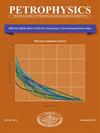将润湿性从纳米级提升到核心级的工作流程
IF 0.7
4区 工程技术
Q3 ENGINEERING, PETROLEUM
引用次数: 14
摘要
润湿性是影响多孔介质中多相流动的关键因素。除了平均接触角外,整个多孔介质中接触角的空间分布也很重要,因为它直接控制润湿相和非润湿相的连通性。控制因素可能不仅与矿物的表面化学有关,还与它们的质地有关,这意味着必须考虑从纳米到厘米的长度范围。到目前为止,还不存在通过不同规模一致解决润湿性问题的集成工作流程。在这项研究中,我们通过将微计算机断层扫描(mu-CT)成像与原子力显微镜(AFM)相结合,证明了这种工作流程是可能的。我们发现,在由99.9%具有双重孔隙结构的方解石组成的碳酸盐岩中,润湿性最终由矿物的表面纹理控制。岩石内的粗糙度和纹理变化控制着初始化适当的原油-岩石接触所需的毛细管压力,从而允许老化和随后的润湿性改变。AFM使我们能够表征这种表面-流体相互作用并研究表面纹理。在这项研究中,我们使用AFM对原生水饱和度下的纳米级流体配置进行了3D成像,并将流体配置与岩石表面的模拟进行了比较,假设毛细管压力不同。本文章由计算机程序翻译,如有差异,请以英文原文为准。
Workflow for Upscaling Wettability from the Nanoscale to Core Scale
Wettability is a key factor influencing multiphase flow in porous media. In addition to the average contact angle, the spatial distribution of contact angles throughout the porous medium is important, as it directly controls the connectivity of wetting and nonwetting phases. The controlling factors may not only relate to the surface chemistry of minerals but also to their texture, which implies that a length-scale range from nanometers to centimeters has to be considered. So far, an integrated workflow addressing wettability consistently through the different scales does not exist. In this study, we demonstrate that such a workflow is possible by combining microcomputed tomography (mu CT) imaging with atomic-force microscopy (AFM). We find that in a carbonate rock, consisting of 99.9% calcite with a dual-porosity structure, wettability is ultimately controlled by the surface texture of the mineral. Roughness and texture variation within the rock control the capillary pressure required for initializing proper crude oil-rock contacts that allow aging and subsequent wettability alteration. AFM enables us to characterize such surface-fluid interactions and to investigate the surface texture. In this study, we use AFM to image nanoscale fluid-configurations in 3D at connate water saturation and compare the fluid configuration with simulations on the rock surface, assuming different capillary pressures.
求助全文
通过发布文献求助,成功后即可免费获取论文全文。
去求助
来源期刊

Petrophysics
地学-地球化学与地球物理
CiteScore
1.80
自引率
11.10%
发文量
40
审稿时长
>12 weeks
期刊介绍:
Petrophysics contains original contributions on theoretical and applied aspects of formation evaluation, including both open hole and cased hole well logging, core analysis and formation testing.
 求助内容:
求助内容: 应助结果提醒方式:
应助结果提醒方式:


